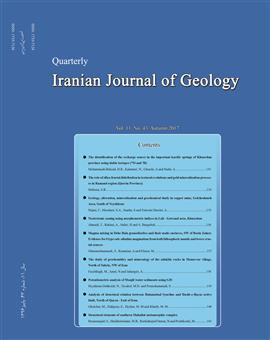The role of silica fractal distribution in textural evolutions and gold mineralization processes in Ramand region (Qazvin Province)
Subject Areas :
1 -
Keywords: Textural evolution, Silica distribution Fractal Ramand Gold mineralization.,
Abstract :
Ramand region is a part of Urmia-Dokhtar magmatic belt that is located among a variety of crossed faulted structures and magmatic occurrences including Paleogene rhyolite and rhyodacite formations as the major related host units to hydrothermal ore deposits. Different kinds of clayey, silicified and Fe-rich alterations indicate a post magmatic vein type mineralization potential along Ramand crushed zones and structures. Well-developed alterations have been extended around volcanic extrusions with variety of textural zonation in quartz and chalcedonic vein systems similar to epithermal deposits. This research introduces a fractal based technique (Area-Concentration function) to obtain the priority map of Au-mineralization with an emphasis on quartzitic-pyritic textural evolutions in Ramand region. As a rule, self-organized crystallized textures (such as crustiform quartz) have more valuable ore content than glassy textures (vitrophiric), because of stepwise enrichment advantages in the hypogenic environment of epithermal deposits. Litho-geochemical sampling is the main and prior procedure for studying quartz textural zonation as well as instrumental quantitative measurement of the elements. Results showed a volcanic hosted formation with crustiform quartzitic textures is mineralized in the western part of Ramand region. Mineralized veins are specified by silica nonlinear distribution (SiO2) related to textural evolutions in the quartz-hematite facies (Au=820 ppb) as the main targets for detail explorations.
-آقانباتی، ع، 1383. زمینشناسی ایران، نشر سازمان زمینشناسی و اکتشافات معدنی ایران، 527.
-توکل، ر.، مهرنیا، س.ر.، نظافتی، ن. و شیخ ذکریایی، ج.، 1392. توزیع ژئوفرکتالی سیلیس و ارتباط آن با کانه زایی طلا در محدوده نیکویه (استان قزوین)، مجله زمینشناسی کاربردی پیشرفته، دانشگاه شهید چمران اهواز، 8 (1) ، 46-34.
-حسنی پاک، ع.ا.، 1387. اصول اکتشافات ژئوشیمیایی. انتشارات دانشگاه تهران، ایران، 615.
-کریم¬پور، م.ح.، ملکزاده، آ. و حیدریان، م. ر.، 1387. اکتشاف ذخایر معدنی. نشر دانشگاه فردوسی مشهد، ایران، 632.
-مهرنیا، س. ر.، 1392. کاربرد هندسه فرکتال در شناسایی الگوی ناحیه بندی بافتی ذخایر اپی ترمال- مطالعه موردی اندیس مس شیخ درآباد (آذربایجان شرقی). نشریه زمینشناسی اقتصادی، دانشگاه فردوسی مشهد، 5 (1) ، 36-23.
- Akbari, E. and Mehrnia, S.R, 2013. Association of silica fractal distribution with gold mineralization: a case study from Takmeh Dash region, North West of Iran, Journal of Tethys, 1(4): 241-253.
-Crosta, A. P. and Moore, J. Mc., 1989. Enhancement of Landsat Thematic Mapper imagery for residual soil mapping in SW Minais Gerais State, Brazil: a prospecting case history in Greenstone belt terrain. In: Proceedings of the seventh ERIM thematic conference: remote sensing for exploration geology.1173–1187.
-Ezzati, S.A., Mehrnia, S.R. and Ajayebi, K., 2015. Remotely sensed ore mineralization potentials in Ramand altered region, north of Iran. American Journal of Civil Engineering, 3(2-2), 18-23.
-Hedenquist J. W., Arribas, A. and Izawa, E., 2009. Epithermal gold deposits, styles, characteristics and Exploration. American Society of Resource Geology, 12 (4), 83.
-Mandelbrot, B., 2006. The Fractal Geometry of Nature. W.H Freeman & Company, New York,468.
-Morison, G. and Guoyi, D. 2001. Textural Zoning in Epithermal Quartz Veins, AMIRA Project, J.C University, Queensland,129.
-Turcotte, D., 1997. Fractals and Chaos in Geology and Geophysics, Cambridge University, Cambridge,398.


